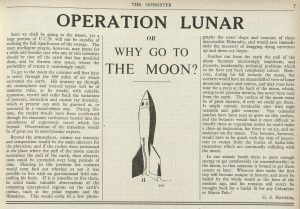July 20, 2019, by Nicholas Blake
To the Moon! Descriptions of Lunar Travel in the Special Collections
In 1947 a University College Nottingham student wrote an article for student newspaper The Gongster called “Operation Lunar, or, Why go to the Moon?”. The lunar voyage is imagined as a perilous affair with little hope of the intrepid explorer returning alive, due to cosmic ray intensity, the unknown effects of zero-gravity on the body, and the threat of being hit by the bullet-like meteorites which constantly pepper the Moon’s surface. “Whoever does make the first trip will become unique in history, and must be hailed by the whole world as the hero of the modern age, and his remains will surely be brought back for a burial fit for any Columbus or Marco Polo!” Although the student believed that the first visit to the Moon would happen in the very near future, they suggested this would only be appreciated by “more intelligent people”, and that “a large portion of University College Nottingham will not be capable of realising the full significance of the voyage”. But dreams of journeying to the Moon were never the sole preoccupation of precocious students from the early 20th century, and within the Special Collections we have found various depictions of the quest to reach the lunar surface, from the scientific to the satirical.
Early works of cosmology from the 17th century often found the scientific part of science hard to ratify against commonplace theological beliefs, which is why Thomas Burnet suggests in Telluris theoria sacra (written in 1689) that the Earth must be hollow and full of water, for where else, realistically, could all the water which caused Noah’s flood have come from? In contrast, the French philosopher Bernard Le Bovier de Fontenelle had no such qualms in ignoring religious doctrine in his seminal work, Conversations on the plurality of worlds. Originally published in 1686, his book was deliberately aimed at a more general readership and is considered one of the first works of popular science. Writing in French rather than Latin (the traditional language favoured for scientific works) and with a narrative structured around a philosopher conversing with an unnamed Marchioness, Fontenelle was delighted to ignore established religious teachings in favour of his outlandish theories. “The art of flying is yet in its infancy, it may hereafter be brought to perfection ; and the time may come when mankind may fly to the Moon”, the philosopher says to the Marchioness, in words written over two centuries before the first powered flights (p.112). She is less than convinced, however, responding that mankind is more likely to “break their necks” trying. The philosopher concedes that it is perhaps more likely the inhabitants of the Moon are more advanced in flight and will reach the Earth first. Fontenelle reasoned that for years it was believed that man could not exist in various hot and cold climates, but as more and more civilisations were discovered living in Earth’s most treacherous parts, it stands to reason there is still much more to discover. Our copy of the book, an English translation from 1760, includes an introduction which describes his idea of life on other worlds as an “embarrassing point” for the world of Theology (p.xiv).
The idea of the Moon being inhabited was not merely the fantasy of the godless, as exhibited by Joseph Campbell in his pamphlet, A journey to the moon, and interesting conversations with the inhabitants, respecting the condition of man, published around 1820. Primarily a religious satire and full of daft humour, Campbell imagines himself embarking on an impromptu trip to the Moon while gazing at it through a telescope one night, ascending towards its surface at around a thousand miles an hour. Despite this speed it takes him several days to reach his destination, but thankfully he doesn’t starve because his pockets are “half-full of plumb cakes”. Once he has descended through the Moon’s clouds he is hailed with shouts from the lunar inhabitants who quiz him thoroughly about the Earth and whether the occupants of that planet have heard of God. The lunar people turn out to be deathless, for they had not been granted the same curse that befell Adam when he succumbed to temptation. They are surprised by Campbell’s stories of the ungodly nature of Earthlings, and pity the “ignorant triflers of our sinful world, who prefer drunkenness, debauchery, sinful amusements, exorbitant riches, flattery, […] to the pleasures of godliness”.
It is not documented whether plumb cakes featured in the Soviet Space Programme, though the Russians were still very keen to discover what effects space travel would have on a living organism. Published propaganda we hold, originally collected by Nottingham-based socialist Fred Westacott, show that the USSR was very keen to stress the Soviet republic’s championing of research into jet propulsion since the 1930s, “long before similar work had begun in other countries”. Titled Soviet sputniks, this 1958 pamphlet celebrates Russia’s space programme and each “wonder of the heavens”, explaining the need to send animals into space to assess the effect of air regeneration, temperature control, and weightlessness on the body. The text glosses over the fate of Laika the Dog, who made a one way trip within Sputnik II, but does note that she “did not lose her calm disposition”. Laika’s sacrifice let Russian scientists know that although the human organism “can safely stand any uniform speed”, “there comes a point when man’s senses cannot supply the brain with exhaustive information. […] Astronauts in space flights will be released from having to control their flight themselves, which is literally beyond man’s capacity”. The Sputnik program gave hope to sending a man to the Moon “in the near future”, anticipating that if the rocket travels faster than seven miles an hour, it will be able to reach the Moon in twenty-four hours.
A later booklet, Soviet man in space, published in 1961, brings us up to speed on the latest space endeavours from the USSR, including the time they fired a rocket which crashed into the moon “precisely as planned”, and the myriad more space doggos they blasted above the atmosphere, most of which came back safely. (Belka the Space Dog went on to have six healthy puppies.) Major Yuri Gagarin is the focus of the booklet, who successfully completed the first manned space flight on April 12th, 1961 in the orbital space-ship, Vostok (presumably while twiddling his thumbs as he was relieved of any technical responsibilities). “The first manned space flight ushers in a new era, the space era, in human history. The time has come to fulfill projects that seemed fantastic before – extra-terrestrial scientific observatories and manned space flights to the Moon, to Mars, Venus and the other planets of the solar system.”
Russia ultimately conceded the Race to the Moon, but the rest of the solar system remains up for grabs. As Fontenelle wrote in Conversations on the plurality of worlds, “Do we have to pretend we have discovered every thing, or have we arrived to that point, where, not any thing can be added to our knowledge? Let us with a good grace consent, that there is yet some thing for future ages to do” (p. 112). It may have taken almost three centuries from that book’s original publication for mankind to reach the Moon, but who knows what other scientific and exploratory achievements, speculated now with humour and ridicule, may one day become a reality? Keep dreaming, everybody.
All the material discussed in this blog is available to view by anybody in our Reading Room at Manuscripts and Special Collections, King’s Meadow Campus. Please visit www.nottingham.ac.uk/mss or email mss-library@nottingham.ac.uk for more information.
Material featured:
- Burnet, T. Telluris theoria sacra : orbis nosti originem & mutations generals, quas aut jam subiit, aut olim subiturus est, complectens. (Londini : Typis R N Impensis Gault Kettilby ad insigne Capitis Episcopi in Coemeterio Paulino MDCLXXXIX [1689]). Ashby Parish Library BL224.B8 (1007985772)
- Campbell, J. A journey to the moon, and interesting conversations with the inhabitants, respecting the condition of man. (London : Printed and sold by J Evans and Sons, [1814-1820]). Special Collection Pamphlet PR975.C2 (SC204113)
- Fontenelle, M. Conversations on the plurality of worlds / A new translation from the last edition of the French. (London : printed for R Withy MDCCLX [1760]). Special Collection QB54 FON (SC122818)
- Hawkins, G.S. ‘Operation lunar, or, Why go to the moon?’. The gongster / University College Nottingham. 31st October 1947, p.7. University of Nottingham Collection os.X.Periodicals Not 5.G14.1
- Neison, E. The moon and the condition and configurations of its surface. (London : Longmans Green and Co 1876). Special Collection QB591 NEI (SC27515)
- Soviet man in space (London : Soviet Booklets 1961). Fred Westacott Printed Collection Pamphlet TL796.5.R8.S6 (1007332146)
- Soviet sputniks (London : Soviet news 1958). Fred Westacott Printed Collection Pamphlet TL796.5.R8.S6 (1007689986)
No comments yet, fill out a comment to be the first



![Cover of pamphlet, A journey to the moon, and interesting conversations with the inhabitants... by John Campbell, [1814-1820]](https://blogs.nottingham.ac.uk/manuscripts/files/2019/07/19-37648p-A-journey-to-the-moon-213x300.jpg)


Leave a Reply